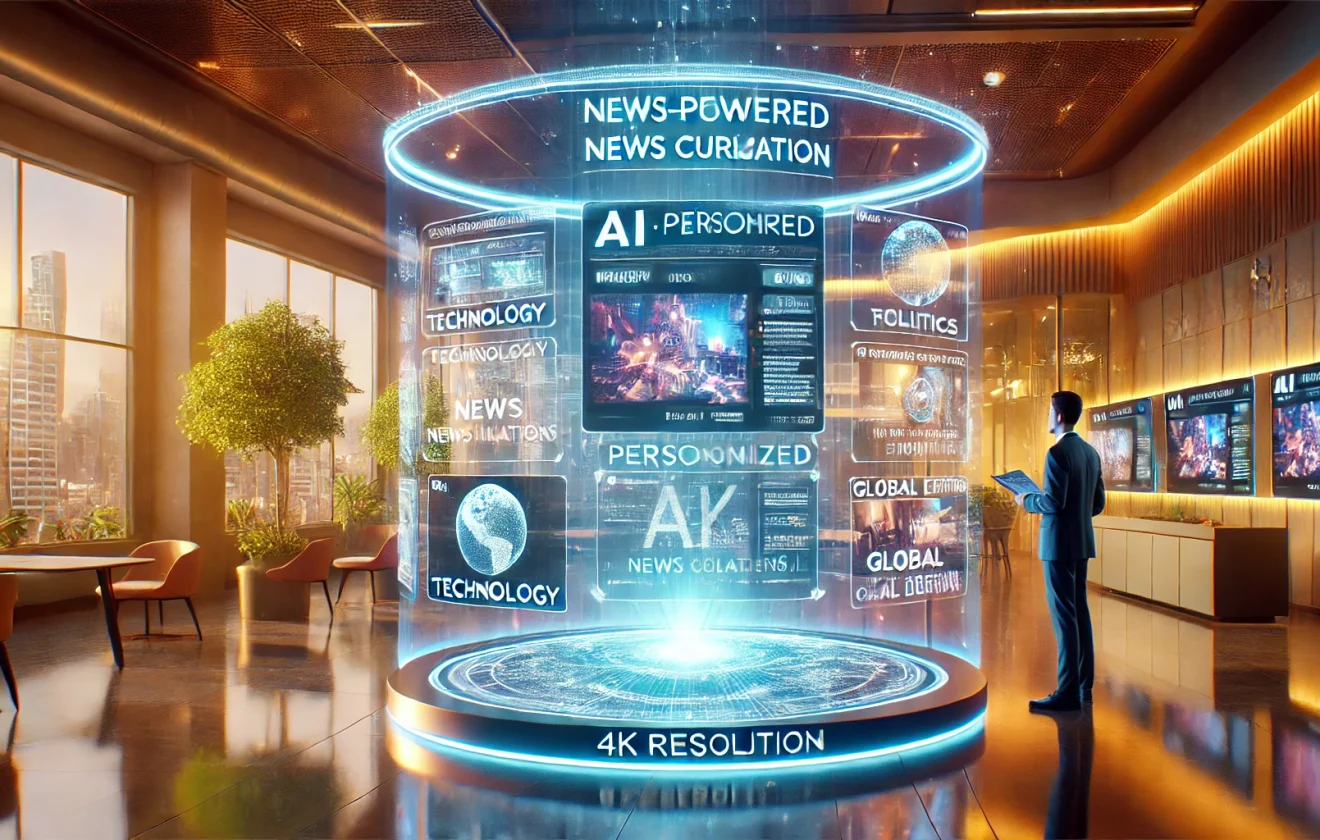AI-Powered News Curation: Personalized Headlines or Echo Chambers?
In a world of information overload, staying informed can be a daunting task. Every day, millions of articles, videos, and news stories flood the internet....

- The Appeal of AI-Powered News Curation (AIDA Framework)
- How AI-Powered News Curation Works
- The Benefits: Why Personalization Matters
- The Risks: Are We Trapped in Echo Chambers?
- Striking the Balance: Solutions for Better Curation
- Case Study: Success and Controversy in AI News Platforms
- FAQ Section
- <strong>Q1: How does AI news curation differ from traditional news aggregation?</strong>
- <strong>Q2: Can I opt out of AI curation?</strong>
- <strong>Q3: Are there unbiased news curation platforms?</strong>
- <strong>Q4: How can I ensure a balanced news diet?</strong>
- <strong>Q5: What’s the future of AI in news curation?</strong>
- Conclusion
In a world of information overload, staying informed can be a daunting task. Every day, millions of articles, videos, and news stories flood the internet. It’s nearly impossible to sift through it all to find the news that truly matters to you. Enter AI-powered news curation, a technological marvel that promises to make this process seamless and personal. But while the convenience is undeniable, there’s a growing concern: are we unwittingly stepping into echo chambers, where diversity of thought is sacrificed for algorithmic efficiency?
In this article, we’ll dive deep into how AI news curation works, its benefits, and the potential pitfalls. We’ll explore whether it’s a force for personalization or a breeding ground for polarization—and what this means for the future of news consumption.
The Appeal of AI-Powered News Curation (AIDA Framework)#
Attention#
Imagine opening your news app in the morning, and every headline feels like it was written with you in mind. Stories on your favorite sports team, the latest policy updates in your country, and thought-provoking op-eds all greet you. Sounds perfect, doesn’t it?
Interest#
AI-powered news curation taps into machine learning and natural language processing to tailor news based on your reading habits, preferences, and even location. By analyzing your behavior, the algorithm presents a curated feed that aligns with your interests, saving you time and ensuring relevance.
But there’s a flipside to this convenience. Critics argue that this hyper-personalization creates a “filter bubble,” isolating you from perspectives that challenge your views. The more the AI learns about you, the narrower your worldview may become.
Desire#
What if AI could strike the perfect balance? Personalized headlines that cater to your interests, but with a sprinkling of diverse perspectives to keep you informed and open-minded. It’s a tantalizing prospect: having an AI assistant that empowers your decision-making instead of limiting it.
Action#
Before we can realize this vision, it’s crucial to understand how AI curation works, what risks it poses, and how we, as users, can navigate this brave new world.
How AI-Powered News Curation Works#
At the heart of AI news curation are algorithms designed to process vast amounts of data. Here’s a breakdown of how it functions:
1. Data Collection#
AI systems gather data about your reading habits. This includes:
- The types of articles you click on.
- How much time you spend reading them.
- The topics you search for.
- Social media interactions, such as likes, shares, and comments.
2. Machine Learning Models#
The collected data feeds machine learning models, which analyze patterns and preferences. For instance, if you frequently read about climate change, the algorithm learns to prioritize environmental news in your feed.
3. Content Recommendation#
Once the system has mapped your preferences, it curates a feed tailored to you. This involves ranking articles based on relevance and even predicting what you’ll find engaging.
4. Feedback Loop#
Every interaction you have with the curated feed provides further data, fine-tuning the recommendations over time.
The Benefits: Why Personalization Matters#
AI-powered news curation isn’t just a luxury—it can revolutionize how we consume information.
1. Time Efficiency#
In a fast-paced world, having a personalized feed means less time searching for relevant news and more time absorbing it.
2. Enhanced Relevance#
By focusing on your interests, AI ensures that you’re not bombarded with irrelevant stories. This relevance can lead to deeper engagement with the news.
3. Accessibility#
AI curation can adapt to different demographics, languages, and literacy levels, making news consumption more inclusive.
4. Breaking News Alerts#
AI excels at delivering timely updates. Whether it’s a natural disaster, a political upheaval, or a stock market crash, you’ll know about it instantly.
The Risks: Are We Trapped in Echo Chambers?#
While the benefits are compelling, the risks of AI-driven news curation are just as significant.
1. Filter Bubbles#
As algorithms cater to your preferences, they may exclude viewpoints that challenge your beliefs. Over time, this creates an echo chamber where your opinions are constantly reinforced, limiting critical thinking.
2. Polarization#
Echo chambers don’t just isolate individuals—they can polarize societies. When opposing groups are fed completely different narratives, finding common ground becomes increasingly difficult.
3. Lack of Accountability#
Algorithms aren’t neutral. They’re designed by humans, and biases can seep into their programming. Without transparency, it’s hard to know why certain stories are prioritized.
4. Privacy Concerns#
To deliver personalized news, AI systems collect vast amounts of personal data. This raises questions about how that data is stored, used, and protected.
Striking the Balance: Solutions for Better Curation#
1. Algorithm Transparency#
News platforms should disclose how their algorithms work, ensuring users understand the criteria behind their curated feeds.
2. Diverse Content Exposure#
Incorporating mechanisms that introduce diverse viewpoints can mitigate the risk of echo chambers. For example:
- Highlighting trending stories outside your typical interests.
- Introducing “opposing view” sections in the feed.
3. User Control#
Giving users more control over their preferences can improve the curation experience. For instance, sliders to adjust the balance between personalized and general news.
4. Ethical AI Practices#
Platforms must prioritize ethical considerations, such as avoiding sensationalism and ensuring data privacy.
5. Media Literacy Education#
Teaching users how to critically evaluate news sources and recognize biases can complement AI-driven curation.
Case Study: Success and Controversy in AI News Platforms#
The Success of Google News and Flipboard#
Google News and Flipboard are prime examples of AI-driven platforms that balance personalization with diversity. Google News uses AI to highlight both local and global stories, while Flipboard allows users to create “magazines” based on specific topics.
The Facebook Dilemma#
Facebook’s news feed algorithm has faced criticism for amplifying divisive content. Studies have shown that emotionally charged stories, whether true or false, often receive higher engagement, pushing them to the forefront.
FAQ Section#
Q1: How does AI news curation differ from traditional news aggregation?#
AI news curation uses machine learning to personalize content, while traditional news aggregation simply compiles articles from various sources without tailoring them to individual preferences.
Q2: Can I opt out of AI curation?#
Yes, many platforms offer the option to view unpersonalized feeds or manually select topics of interest.
Q3: Are there unbiased news curation platforms?#
No platform is entirely unbiased. However, some, like BBC News or Reuters, strive to maintain editorial neutrality in their content.
Q4: How can I ensure a balanced news diet?#
Follow multiple news sources, use platforms with diverse content policies, and seek out opposing viewpoints to avoid echo chambers.
Q5: What’s the future of AI in news curation?#
As AI evolves, we can expect more sophisticated algorithms that balance personalization with diversity, fostering informed and open-minded readership.
Conclusion#
AI-powered news curation is a double-edged sword. On one hand, it offers unparalleled convenience and relevance, transforming how we consume information. On the other, it poses risks of creating echo chambers and exacerbating societal divides.
To unlock its full potential, we must demand transparency, embrace diverse perspectives, and use these tools responsibly. After all, the goal of news isn’t just to inform—it’s to empower us to think critically and engage with the world.
With the right balance, AI-powered news curation can become a beacon of progress, delivering not just personalized headlines but also a richer, more nuanced understanding of our shared reality.















The AI regulation and compliance section is spot on. With the rise of AI adoption, ethical considerations will be crucial.…